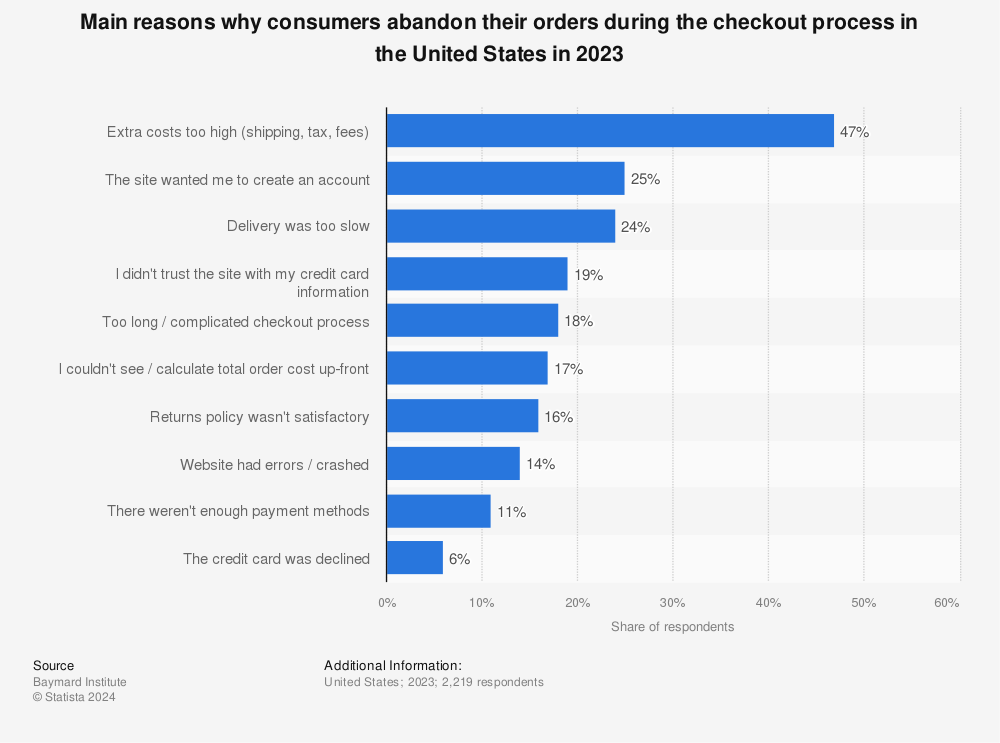
Subscribe to our newsletter

Data indicate that more than a half of the customers abandon the cart during the checkout process. Why is shopping cart abandonment a problem? Well, it translates into huge losses for e-commerce sites around the world. The question remains: what causes this high rate of cart abandonment? How to deal with it?
Cart abandonment rate is the percentage of customers who add items to their cart but leave the site without completing their purchase. It is said that on average, cart abandonment rate hovers around 69.99% to 75.6%, depending on the industry. In 2024, according to Statista, average cart abandonment rate is 70,19%.
To calculate it, taking into account your own data, use cart abandonment rate formula:
Abandonment Rate = (1− Shopping Carts Created/Completed Purchases)×100
Online shopping cart abandonment is a significant problem for e-commerce retailers. It directly impacts revenue and conversion rates. When customers add items to their cart but do not complete the purchase, it results in lost sales opportunities. Statistics indicate that the average cart abandonment rate is around 69.57% to 75.6%. It means that a substantial portion of potential revenue is left unrealized.
The reasons for cart abandonment are varied and often point to underlying issues with the user experience. Common factors include unexpected costs, complicated checkout processes, and security concerns, all of which can deter customers from finalizing their purchases. For instance, high shipping fees or hidden charges can lead to feelings of distrust, prompting customers to abandon their carts in search of better deals elsewhere. Additionally, a confusing or lengthy checkout process can frustrate users. Therefore, it leads them to abandon their purchases altogether.
Addressing these issues is crucial for e-commerce businesses. By understanding the root causes of cart abandonment, retailers can implement strategies to enhance the shopping experience. For instance, simplifying the checkout process, offering transparent pricing, and providing multiple payment options. Ultimately, reducing cart abandonment not only improves sales but also fosters customer loyalty and satisfaction, making it a critical focus for online retailers.
Shopping cart abandonment statistics of Statista list a number of main reasons why customers do not finish their purchase. We will discuss top problems and suggest how you can deal with these challenges as a store owner.

Find more statistics at Statista
Shipping costs
The majority of customers abandon the cart due to high shipping costs. The average cost of shipping has been increasing since 2016, largely due to a rise in fuel prices as well as an increase in demand for e-commerce deliveries caused by a growing number of online shoppers.
Some retailers offer free shipping under certain conditions — such as free shipping over a certain amount or signing up for loyalty programs. However, even this strategy can backfire if your requirements aren’t clearly communicated upfront and thereby leave some potential buyers feeling misled into thinking they’ll be paying nothing at all when checking out. A good way to avoid this is by showing the exact amount when a customer selects their country during checkout. Get familiar with shipping tools for Shopify or Woocommerce by Octolize which will help you in managing shipping costs.
Customs and handling fee
Customs and handling fees are similar but slightly different from other types such as taxes because these don’t necessarily apply only when someone lives outside their country’s borders. It could rather also happen within one’s own country due to local regulations too! So while this may be easier on consumers who live overseas since there aren’t any additional taxes applied during checkout. It still won’t stop merchants from making money off those who shop domestically at times either (though I’m sure there’s some sort of legal reason behind why this happens).
Insurance
It could occur that the store offers more expensive orders. In this case, there would be an extra cost called insurance. High-priced or fragile orders need to be treated carefully. Therefore, in some cases it might be necessary to pay higher or extra shipping costs.
If you’re still forcing customers to register for an account before they can complete the checkout process, then you’re leaving money on the table. Many customers don’t want to create an account just so they can buy something from your store. Hence, they won’t be coming back again, nor are they likely to recommend your business if their experience was less than pleasant.
If you want to keep in touch with your customers, emphasize the advantages of signing up to your site or marketing communication, so even if subscribing is optional, it would remain an attractive option.
You can’t prevent fraud, but you can help protect your customers’ data. The third most common reason for cart abandonment is security concerns. This can be a direct result of fraud and credit card theft, which is a serious problem that’s more prominent than ever on the internet today. But even if this isn’t your store’s issue, it’s still important to consider how customers perceive you as an online merchant.
Display recognizable security badges from trusted third-party organizations (such as Norton, McAfee, or PCI Compliance) on your checkout page. These badges can significantly enhance customer confidence. They signal that your site adheres to industry-standard security practices. Create also a transparent privacy policy that outlines how customer data will be collected, used, and protected. It is also worth implementing SSL Certification on a website, if you don’t already have it.
Time is money, especially in e-commerce. Customers usually want to receive their package before important events such as birthdays, ceremonies, etc. When faced with long delivery times, many shoppers will abandon their cart, opting instead to find a retailer that can deliver their items more quickly. As you could see on the chart at the top of this article, nearly a quarter of customers citing it as a major factor in their decision to leave a site without completing their purchase. Offering expedited shipping options, providing accurate delivery estimates, and ensuring timely fulfillment is crucial for e-commerce businesses looking to reduce abandonment rates and keep customers satisfied. One of the plugins which provides accurate estimated delivery times would be FedEx WooCommerce Shipping Plugin – Live Rates PRO.
Reasonably priced international delivery. Enable FedEx live rates for WooCommerce, save money and display the dynamically calculated shipping cost to your customers.
View Details or Add to cartIf you have a lot of form fields, try to group them into sections. It should be obvious where to put personal information and what each field is asking for. You can do this by using labels or icons next to the fields. Therefore, the users know what they’re supposed to enter. For example, an asterisk next to a field means that you need to type the number “1” in it. Your checkout process should be smooth and easy to follow.
The cart abandonment problem has long been a thorn in the side of eCommerce sites. One of the biggest obstacles for e-commerce companies is that their users are using mobile devices more and more to browse and buy online. According to the survey by Statista, the mobile cart abandonment rate is increasing in the U.S., reaching 84% in the second quarter of 2022.
With the rise of mobile usage comes a growing number of potential customers who are abandoning carts. The reason is that, they can’t complete the checkout process on their phones or tablet. It’s important for eCommerce companies like yours to make sure that your checkout experience is optimized for mobiles. In this case, you don’t lose out on sales when customers try to check out with you through their phone or tablet!
One of the most important things to consider when considering your checkout process is how many payment options you offer. Many customers will abandon the cart if they can’t find their preferred payment option.
Offering multiple forms of payments has another advantage. It allows new shoppers or those living outside the US where many businesses aren’t set up for international transactions (and therefore cannot accept overseas checks) another option for making purchases online.
There are many plugins for conversion, and some are better than others. You should check the best plugins on the Octolize website.
While you can’t completely prevent customers from abandoning their carts, there are several strategies you can implement to recover lost sales and improve your overall conversion rate:
To get more thoroughly familiar with recovering strategies and useful tools for improving conversion rate, see full article: Abandoned cart recovery.